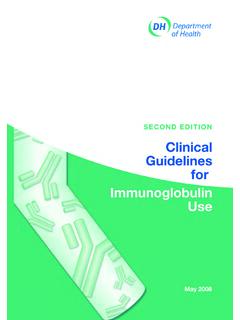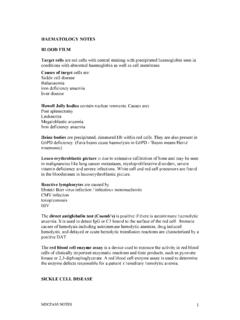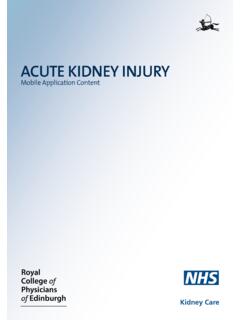Transcription of Animal contact guidelines – reducing the risk to human ...
1 Animal contact guidelines . reducing the risk to human health 2014. Interim Animal contact guidelines reducing the risk to human health, 2014 -i- Acknowledgements The Animal contact guidelines reducing the risk to human health, 2014 (new edition). acknowledges the original document prepared by the Department of human Services, Government of South Australia. The permission of the South Australian Government for Queensland Health to adapt their document continues to be very much appreciated. This edition acknowledges the contribution of all parties who were involved in the original version. This current edition was developed with the support and expert advice from: Cairns Public Health Unit, Cairns and Hinterland Hospital and Health Service Darling Downs Public Health Unit, Darling Downs Hospital and Health Service Metro North Public Health Unit, Metro North Hospital and Health Service Queensland Department of Education, Training and Employment Sunshine Coast Public Health Unit, Sunshine Coast Hospital and Health Service Workplace Health and Safety Queensland Animal contact guidelines reducing the risk to human health, 2014.
2 Published by the State of Queensland (Queensland Health), August 2014. ISBN: 978 1 876532 95 6. This document is licensed under a Creative Commons Attribution Australia licence. To view a copy of this licence, visit State of Queensland (Queensland Health) 2014. You are free to copy, communicate and adapt the work, as long as you attribute the State of Queensland (Queensland Health). For more information contact : Notifiable Diseases Prevention & Control, Communicable Diseases Unit, Department of Health, GPO Box 48, Brisbane QLD 4001, email phone 3328 9724. An electronic version of this document is available at Disclaimer: The content presented in this publication is distributed by the Queensland Government as an information source only. The State of Queensland makes no statements, representations or warranties about the accuracy, completeness or reliability of any information contained in this publication. The State of Queensland disclaims all responsibility and all liability (including without limitation for liability in negligence) for all expenses, losses, damages and costs you might incur as a result of the information being inaccurate or incomplete in any way, and for any reason reliance was placed on such information.
3 Animal contact guidelines reducing the risk to human health, 2014 - ii - Contents 1. Zoonotic infections .. 1. Aim .. 2. The ways zoonotic diseases are spread .. 3. Groups at increased risk .. 6. Avoiding high-risk activities .. 7. Young 7. Pregnant women .. 8. Immuno-compromised adults or children .. 8. Older 9. People with known 9. Recommendations for providers of Animal contact opportunities .. 9. What precautions should operators take? .. 9. Hand 10. Requirements for hand washing facilities .. 11. Steps to clean hands .. 11. Temporary and mobile hand washing 12. Emergency hand washing 12. Recommendations for pet shops .. 13. Recommendations for animals in healthcare facilities .. 14. Specific information for schools and early childhood education and care services .. 14. Legal obligations for Animal contact areas .. 14. Environmental health officer .. 15. Contacts .. 15. Appendix 1: Routes of transmission .. 16. Ingestion.
4 16. 16. Urine 16. Consumption (eating or drinking contaminated food or water) .. 16. Inhalation .. 16. Skin or mucous membrane contact .. 17. Appendix 2: Specific information for providers of Animal contact opportunities .. 19. What precautions should operators take .. 19. Appendix 3: Recommendations for pet shops .. 32. Responsibilities of management and staff .. 32. Animal welfare .. 32. Facilities .. 33. Hygiene .. 33. 34. Animal contact guidelines reducing the risk to human health, 2014 - iii - Appendix 4: Animals in healthcare 36. Suitable animals .. 36. Veterinary clearance .. 37. People at increased risk of illness .. 37. Infection control 37. Hand washing .. 38. Managing contact between animals and people .. 38. Law enforcement and assistance animals .. 38. Illness after contact with animals .. 39. Appendix 5: Specific information for schools, early education and care services .. 40. Before the visit .. 41. During the visit.
5 41. After the visit .. 42. Glossary .. 44. References .. 45. Tables Table 1 Zoonotic disease outbreaks in Australia 2002 to 2013 .. 1. Table 2 Routes of transmission .. 4. Animal contact guidelines reducing the risk to human health, 2014 - iv - Introduction These guidelines contain important information that can reduce the risk of visitors contracting an infection from animals when visiting an Animal farm or show, petting zoo, wildlife exhibit and other similar settings offering visitors the opportunity of seeing and coming into contact with animals. Visiting these venues does present a low, but possible, risk to visitors. Zoonotic infections Zoonoses are infections that can be passed from animals to humans. Sources of zoonoses reported in Australia include cattle, sheep, horses, goats, pigs, guinea pigs, ferrets, dogs, cats, poultry, birds, tropical fish, rodents, amphibians, reptiles (including turtles and tortoises), bats and other species of native wildlife.
6 Reports of human illness associated with Animal contact through farms, shows, zoos, petting zoos and wildlife exhibitors are infrequent in Australia. However, where illness does occur, the disease can be serious, especially for: infants and young children pregnant women older adults people with compromised immune systems. Table 1 provides details of outbreaks where there has been direct or indirect contact with animals in Australia. Providers of Animal contact opportunities have a duty under the Work, Health and Safety Act 2011 to ensure the health and safety of themselves, staff and other persons, so far as is reasonably practicable. Most zoos and wildlife parks (wildlife exhibitors) in Queensland belong to a recognised industry association that requires adherence to professional levels in all areas of operation. Animal care in relation to husbandry, health, facilities, safety and hygiene are regulated and subject to various codes of practice and minimum standards.
7 Wildlife exhibitors should work closely with veterinarians to ensure their animals remain in good health. Table 1 Zoonotic disease outbreaks in Australia 2002 to 2013. Location and year Disease Affected Mode of transmission Agricultural show, Shiga toxin-producing 57 cases (65% Direct and indirect Animal Brisbane, Escherichia coli 0157 children) contact via a petting zoo Queensland 2013. Petting zoo, Western Salmonella 5 cases, median Direct and indirect Animal Australia 2013 Typhimurium phage age 3 years contact (STM), pulsed-field gel electrophoresis (PFGE) 13 (type 141). and STM PFGE 303. Aged care facility, Campylobacter 14 residents, 1 staff Animal to person Australian Capital member and 1 transmission Territory 2012 puppy Agricultural show, Shiga-toxin producing 10 cases 2 Direct and indirect Animal Animal contact guidelines reducing the risk to human health, 2014 -1- Adelaide, South Escherichia coli and developed HUS contact via a petting zoo Australia 2011 haemolytic Uraemic (median age 5.)
8 syndrome (HUS) years). Kindergarten farm Cryptosporidiosis 10 children Direct and indirect Animal visit, Western contact Australia 2010. Animal sanctuary, HUS due to 1 child Animal to person Queensland 2007 Enterohaemorrhagic transmission Escherichia coli Poultry hatching Salmonella 6 children Direct contact programs childcare Typhimurium PT 170. centres, Queensland 2003. Petting zoo, South Escherichia coli O26:H 5 people Direct and indirect contact Australia 2002 and secondary transmission to contacts. Aim The guidelines aim to: identify potential disease transmission risks to operators, staff and visitors at petting zoos, Animal farms, wildlife exhibits and similar enterprises in Queensland provide advice on measures to minimise the risk to those managing, coordinating or attending at those venues or events. While these guidelines support visits to these venues, it is recommended that operators identify health risks and implement control measures the most critical of these being proper hand washing after contact with animals.
9 Specific guidance for Animal exhibitors, schools, early education and care services is provided in the appendices. The risk for industry related exposure to zoonotic diseases ( the risk of zoonotic disease transmission in abattoirs) is not within the scope of these guidelines and appropriate guidance should be sought. The measures described here represent good practice. These guidelines aim to provide appropriate control measures for operators to: meet work health and safety requirements and public safety standards reduce the risk to children and adults from contracting zoonoses in these settings. For the purpose of this document, Animal contact ' is the term used to encompass events (including Animal rides), open farms, travelling shows or premises where animals are made available for contact with members of the public whether a fee is charged or not. They include (but are not limited to): agricultural shows and field days Animal exhibits held at shopping centres/early childhood education and care centres, schools animals visiting or resident of an early childhood education and care centre, school or healthcare setting ( classroom pet, egg hatching programs, mini farms, animals used in class room studies, Animal nurseries).
10 Animal contact guidelines reducing the risk to human health, 2014 -2- animals on agricultural farms run by schools Animal nurseries, petting zoos commercial farm visits ( farm stays). wildlife exhibitions nature education centres pet shops travelling farms, mobile exhibits or Animal troupes ( circus, carnivals). wildlife sanctuaries, parks, photo opportunities zoos, wildlife parks, aquaria (wildlife exhibitors). The term Animal contact area' refers to an enclosure or defined area containing a number of enclosures where members of the public are invited, or encouraged to have direct contact with animals ( petting, feeding or holding). In some settings, this contact may occur outside a defined area, for example where a keeper roams with an Animal which the public are actively encouraged to pet. The term Animal contact area' does not encompass every situation where the public may (of their own accord) have contact with animals.















